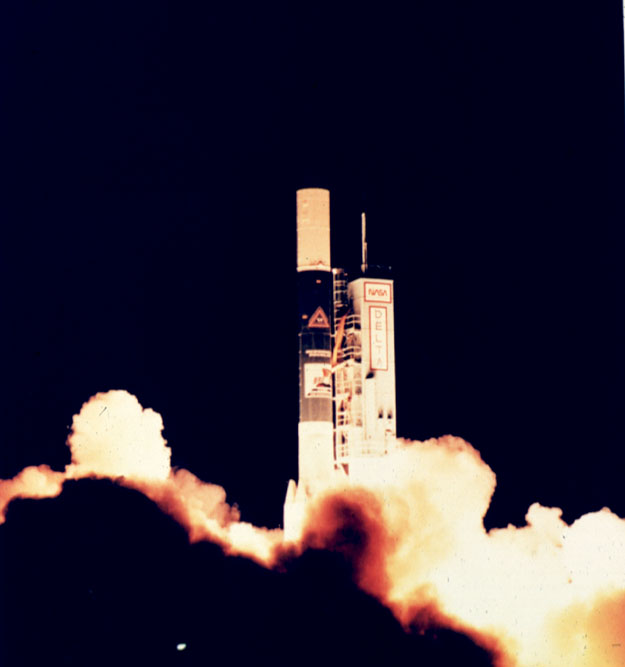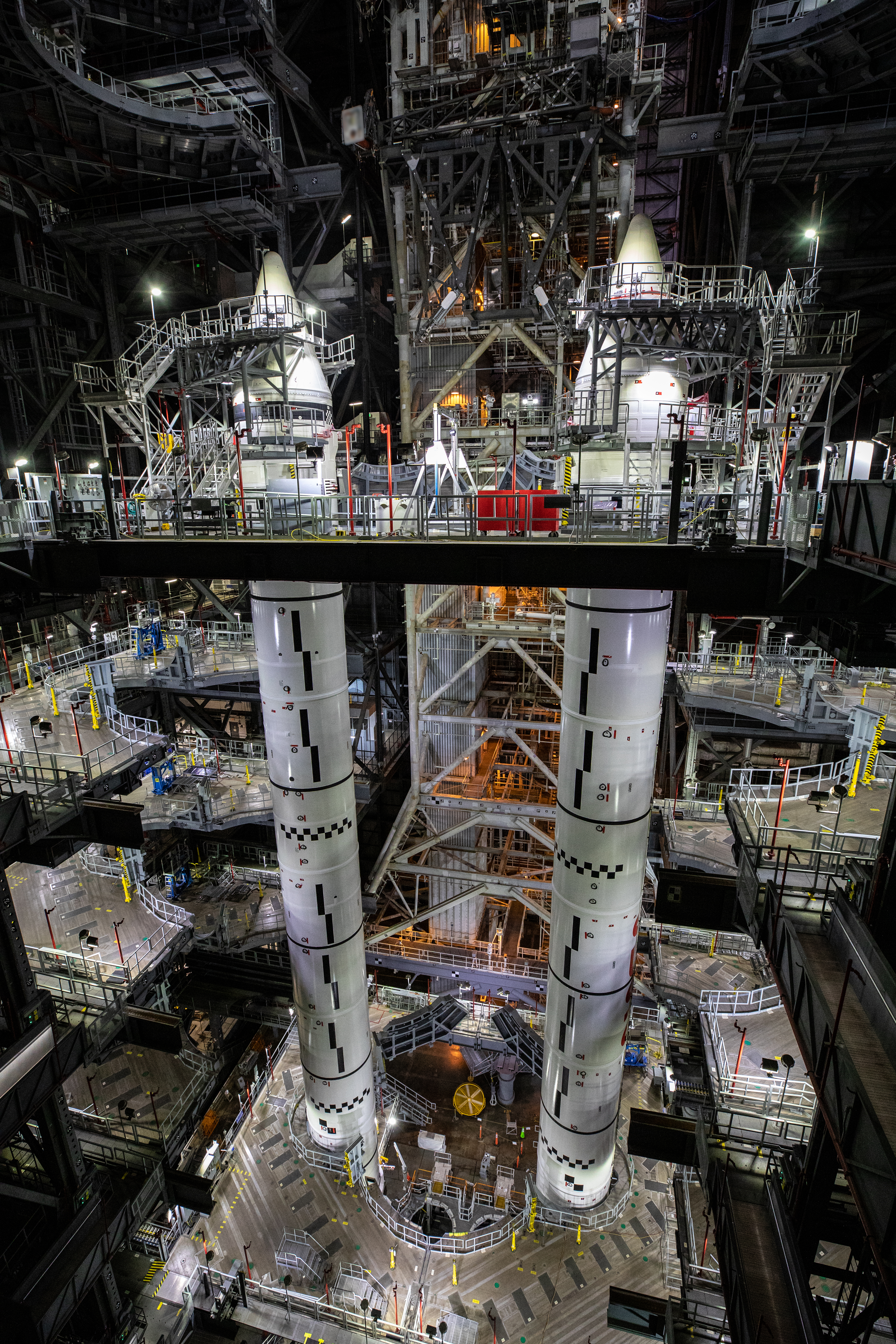|
Delta 5000
The Delta 5000 series was an American expendable launch system which was used to conduct an orbital launch in 1989. It was a member of the Delta family of rockets. Although several variants were put forward, only the Delta 5920 was launched. The designation used a four digit numerical code to store information on the configuration of the rocket. It was built from a combination of spare parts left over from earlier Delta rockets, which were being retired, and parts from the Delta II 6000-series, which was just entering service. The first stage was the RS-27 powered Extended Long Tank Thor, flown on several earlier Delta rockets. Nine Castor-4A solid rocket boosters were attached to increase thrust at lift-off, replacing the less powerful Castor-4 boosters used on the 3000 series. The Delta-K was used as a second stage. In the configuration that was launched, no third stage was flown. The Delta 5000 was launched just once, from Space Launch Complex 2W at the Vandenberg Air F ... [...More Info...] [...Related Items...] OR: [Wikipedia] [Google] [Baidu] |
Cosmic Background Explorer
The Cosmic Background Explorer (COBE ), also referred to as Explorer 66, was a NASA satellite dedicated to cosmology, which operated from 1989 to 1993. Its goals were to investigate the cosmic microwave background radiation (CMB or CMBR) of the universe and provide measurements that would help shape our understanding of the cosmos. COBE's measurements provided two key pieces of evidence that supported the Big Bang theory of the universe: that the CMB has a near-perfect black-body spectrum, and that it has very faint anisotropies. Two of COBE's principal investigators, George F. Smoot and John C. Mather, received the Nobel Prize in Physics in 2006 for their work on the project. According to the Nobel Prize committee, "the COBE project can also be regarded as the starting point for cosmology as a precision science". COBE was the second cosmic microwave background satellite, following RELIKT-1, and was followed by two more advanced spacecraft: the Wilkinson Microwave Anisotro ... [...More Info...] [...Related Items...] OR: [Wikipedia] [Google] [Baidu] |
Delta K
The Delta-K was an American rocket stage, developed by McDonnell Douglas and Aerojet. It was first used on 27 August 1989 as the second stage for the Delta 4000 series. It continued to serve as the second stage for subsequent variants of the Delta rocket. It was propelled by a single AJ10-118K rocket engine, fueled by Aerozine 50 and dinitrogen tetroxide,Delta K , ''Encyclopedia Astronautica'', date 30 Jan 1997, accessed 2011-02-01. which are . The Delta-K had a long heritage to the first Able stage used in |
Castor-4
The Castor family of solid-fuel rocket stages and boosters built by Thiokol (now Northrop Grumman) and used on a variety of launch vehicles. They were initially developed as the second-stage motor of the Scout rocket. The design was based on the MGM-29 Sergeant, a surface-to-surface missile developed for the United States Army at the Jet Propulsion Laboratory. Versions Flown versions Castor 1 :The Castor 1 was first used for a successful suborbital launch of a Scout X-1 rocket on September 2, 1960. :It was long, in diameter, and had a burn time of 27 seconds. Castor 1 stages were also used as strap-on boosters for launch vehicles using Thor first stages, including the Delta-D. (A Delta-D was used in 1964 to launch Syncom-3, the first satellite placed in a geostationary orbit.) Castor 1 stages were used in 141 launch attempts of Scout and Delta rockets, only 2 of which were failures. They were also used on some thrust-assisted Thor-Agena launchers. The last launch us ... [...More Info...] [...Related Items...] OR: [Wikipedia] [Google] [Baidu] |
Solid Rocket Booster
A solid rocket booster (SRB) is a large solid propellant motor used to provide thrust in spacecraft launches from initial launch through the first ascent. Many launch vehicles, including the Atlas V, SLS and space shuttle, have used SRBs to give launch vehicles much of the thrust required to place the vehicle into orbit. The space shuttle used two space shuttle SRBs, which were the largest solid propellant motors ever built and the first designed for recovery and reuse. The propellant for each solid rocket motor on the space shuttle weighed approximately 500,000 kilograms.. Advantages Compared to liquid propellant rockets, the solid-propellant motors SRMs have been capable of providing large amounts of thrust with a relatively simple design. They provide greater thrust without significant refrigeration and insulation requirements, and produce large amounts of thrust for their size. Adding detachable SRBs to a vehicle also powered by liquid-propelled rockets known as staging ... [...More Info...] [...Related Items...] OR: [Wikipedia] [Google] [Baidu] |
Extended Long Tank Thor
Extension, extend or extended may refer to: Mathematics Logic or set theory * Axiom of extensionality * Extensible cardinal * Extension (model theory) * Extension (predicate logic), the set of tuples of values that satisfy the predicate * Extension (semantics), the set of things to which a property applies * Extension by definitions * Extensional definition, a definition that enumerates every individual a term applies to * Extensionality Other uses * Extension of a polyhedron, in geometry * Exterior algebra, Grassmann's theory of extension, in geometry * Homotopy extension property, in topology * Kolmogorov extension theorem, in probability theory * Linear extension, in order theory * Sheaf extension, in algebraic geometry * Tietze extension theorem, in topology * Whitney extension theorem, in differential geometry * Group extension, in abstract algebra and homological algebra Music * Extension (music), notes that fit outside the standard range * ''Extended'' (Solar Fie ... [...More Info...] [...Related Items...] OR: [Wikipedia] [Google] [Baidu] |
Orbit
In celestial mechanics, an orbit is the curved trajectory of an object such as the trajectory of a planet around a star, or of a natural satellite around a planet, or of an artificial satellite around an object or position in space such as a planet, moon, asteroid, or Lagrange point. Normally, orbit refers to a regularly repeating trajectory, although it may also refer to a non-repeating trajectory. To a close approximation, planets and satellites follow elliptic orbits, with the center of mass being orbited at a focal point of the ellipse, as described by Kepler's laws of planetary motion. For most situations, orbital motion is adequately approximated by Newtonian mechanics, which explains gravity as a force obeying an inverse-square law. However, Albert Einstein's general theory of relativity, which accounts for gravity as due to curvature of spacetime, with orbits following geodesics, provides a more accurate calculation and understanding of the exact mechanics ... [...More Info...] [...Related Items...] OR: [Wikipedia] [Google] [Baidu] |
Expendable Launch System
An expendable launch system (or expendable launch vehicle/ELV) is a launch vehicle that can be launched only once, after which its components are either destroyed during reentry or discarded in space. ELVs typically consist of several rocket stages that are discarded sequentially as their fuel is exhausted and the vehicle gains altitude and speed. As of 2022, most satellites and human spacecraft are currently launched on ELVs. ELVs are simpler in design than reusable launch systems and therefore may have a lower production cost. Furthermore, an ELV can use its entire fuel supply to accelerate its payload, offering greater payloads. ELVs are proven technology in widespread use for many decades. ELVs are usable only once, and therefore have a significantly higher per-launch cost than modern (post- STS) reusable vehicles. Current operators Arianespace China ISRO JAXA Roscosmos United States Several governmental agencies of the United States purchase ELV launches. NASA ... [...More Info...] [...Related Items...] OR: [Wikipedia] [Google] [Baidu] |
Aerozine 50
__NOTOC__ Aerozine 50 is a 50:50 mix by weight of hydrazine and unsymmetrical dimethylhydrazine (UDMH), originally developed in the late 1950s by Aerojet General Corporation as a storable, high-energy, hypergolic fuel for the Titan II ICBM rocket engines. Aerozine continues in wide use as a rocket fuel, typically with dinitrogen tetroxide as the oxidizer, with which it is hypergolic. Aerozine 50 is more stable than hydrazine alone, and has a higher density and boiling point than UDMH alone. Pure hydrazine has a higher performance than Aerozine 50, but an unacceptable freezing point. By mixing pure hydrazine with UDMH, hydrazine's inconveniently high freezing point of 2 °C is lowered through freezing-point depression. In addition, UDMH is a more stable molecule; this reduces the chances of straight hydrazine decomposing unexpectedly, increasing safety and allowing the blend to be used as a coolant in regeneratively cooled engines. This type of fuel is mainly used fo ... [...More Info...] [...Related Items...] OR: [Wikipedia] [Google] [Baidu] |
AJ-10
The AJ10 is a hypergolic rocket engine manufactured by Aerojet Rocketdyne (previously Aerojet Aerojet was an American rocket and missile propulsion manufacturer based primarily in Rancho Cordova, California, with divisions in Redmond, Washington, Orange and Gainesville in Virginia, and Camden, Arkansas. Aerojet was owned by GenCorp. ...). It has been used to propel the upper stages of several launch vehicles, including the Delta II and Titan III. Variants were and are used as the service propulsion engine for the Apollo command and service module, in the Space Shuttle Orbital Maneuvering System, and on NASA's Orion spacecraft. Variants It was first used in the Delta-A/Able second stage of the Vanguard rocket, in the AJ10-118 configuration. It was initially fueled by nitric acid and UDMH. An AJ10 engine was first fired in flight during the third Vanguard launch, on 17 March 1958, which successfully placed the Vanguard 1 satellite into orbit. The AJ10-101 ... [...More Info...] [...Related Items...] OR: [Wikipedia] [Google] [Baidu] |
RP-1
RP-1 (alternatively, Rocket Propellant-1 or Refined Petroleum-1) is a highly refined form of kerosene outwardly similar to jet fuel, used as rocket fuel. RP-1 provides a lower specific impulse than liquid hydrogen (LH2), but is cheaper, is stable at room temperature, and presents a lower explosion hazard. RP-1 is far denser than LH2, giving it a higher energy density (though its specific energy is lower). RP-1 also has a fraction of the toxicity and carcinogenic hazards of hydrazine, another room-temperature liquid fuel. Usage and history RP-1 is a fuel in the first-stage boosters of the Electron, Soyuz, Zenit, Delta I-III, Atlas, Falcon, Antares, and Tronador II rockets. It also powered the first stages of the Energia, Titan I, Saturn I and IB, and Saturn V. The Indian Space Research Organization (ISRO) is also developing an RP-1 fueled engine for its future rockets. Development During and immediately after World War II, alcohols (primarily ethanol, occasion ... [...More Info...] [...Related Items...] OR: [Wikipedia] [Google] [Baidu] |



